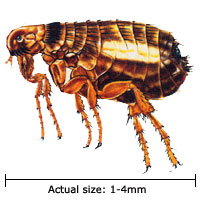
Signs Your Cat May Have Fleas
The most common indication of fleas is, of course, extreme itching. But don't assume that the itching is caused by fleas unless you actually see them. Spread the cat's fur on the rump or in the groin and look for the adult fleas running through the fur. Another way to check is to rub the animal's rump vigorously on to a wet white paper towel. Flea feces are mostly blood, and any black specks that fall on the towel and smear to a reddish-brown color are evidence of flea infestation. As mentioned earlier, an allergic reaction to prolonged exposure to the flea's saliva may cause hair loss, scaliness on the back, and raw patches where the cat has scratched himself.
The most common indication of fleas is, of course, extreme itching. But don't assume that the itching is caused by fleas unless you actually see them. Spread the cat's fur on the rump or in the groin and look for the adult fleas running through the fur. Another way to check is to rub the animal's rump vigorously on to a wet white paper towel. Flea feces are mostly blood, and any black specks that fall on the towel and smear to a reddish-brown color are evidence of flea infestation. As mentioned earlier, an allergic reaction to prolonged exposure to the flea's saliva may cause hair loss, scaliness on the back, and raw patches where the cat has scratched himself.
Control And Treatment Of Fleas In Your Cat
It would be a good idea to consult your veterinarian and, quite possibly, an exterminator. You must treat the infected cat and all the other animals in the household, and you must also treat the animal's indoor and, in some cases, outdoor environment. If the cat has scratched himself raw, cortisone given orally or by injection should clear up the condition.
A number of cat shampoos and dips are available and will effectively kill the fleas. Sprays and powders are quick and effective. With any product, read the manufacturer's instructions carefully before using the product on the cat; some insecticides that are effective for dogs are not safe for cats. Remember, also, that any insecticide you use on your pet can cause side effects like vomiting, excess salivation, or skin irritation. Once you've treated the animal(s), thoroughly clean the house, the cat's sleeping place, and any other areas where the fleas may breed. You can also use fog sprays and bombs available at your pharmacy or local pet store.
It would be a good idea to consult your veterinarian and, quite possibly, an exterminator. You must treat the infected cat and all the other animals in the household, and you must also treat the animal's indoor and, in some cases, outdoor environment. If the cat has scratched himself raw, cortisone given orally or by injection should clear up the condition.
A number of cat shampoos and dips are available and will effectively kill the fleas. Sprays and powders are quick and effective. With any product, read the manufacturer's instructions carefully before using the product on the cat; some insecticides that are effective for dogs are not safe for cats. Remember, also, that any insecticide you use on your pet can cause side effects like vomiting, excess salivation, or skin irritation. Once you've treated the animal(s), thoroughly clean the house, the cat's sleeping place, and any other areas where the fleas may breed. You can also use fog sprays and bombs available at your pharmacy or local pet store.

In some parts of the United States, fleas are a year round problem. In the Northern U.S. and Canada the winter cold will kill fleas outdoors; they can, however, winter quite comfortably in your home.

Prevention And Cures For Fleas And Ticks In Cats
Pet Meds: Dogs | Pet Meds: Cats | Dog Health : By Breed | Cat Health : By Breed | Dog Grooming | Cat Grooming | Pet Top 10's | Pet Food Recipes
Don't Forget About Ticks!
Ticks are about size of a pinhead, and tend to inhabit the parts of the cat where the hair is thin. They will burrow into the cat's skin and feed on the animal's blood. When they are swollen with blood, ticks expand to about the size of a pea. After the tick is finished its meal, it will lay its eggs into a crack or crevice, and drop off the animal. In most cases with cats, you may only find a few ticks, which you can easily remove with tweezers or suffocate with petroleum jelly. If the cat is heavily infected, a "tick bath" may be necessary, followed by periodic use of sprays or powders to prevent further problems.
Ticks are about size of a pinhead, and tend to inhabit the parts of the cat where the hair is thin. They will burrow into the cat's skin and feed on the animal's blood. When they are swollen with blood, ticks expand to about the size of a pea. After the tick is finished its meal, it will lay its eggs into a crack or crevice, and drop off the animal. In most cases with cats, you may only find a few ticks, which you can easily remove with tweezers or suffocate with petroleum jelly. If the cat is heavily infected, a "tick bath" may be necessary, followed by periodic use of sprays or powders to prevent further problems.
Fleas are tiny brown insects that live on the cat's skin and feed by sucking the animal's blood. If you part the cat's fur you can see them moving. Fleas can't fly, but they can jump quite a distance and travel easily from one cat to another. They irritate the skin and make the cat scratch - although not all scratching cats have fleas. And the saliva of the flea is a potent allergen that can set up a severe allergic reaction in a susceptible cat. In such a case the cat will lose a great deal of hair, especially above the tail, and develop scaly skin on his back. He will probably scratch himself so persistently that the skin bleeds. This condition is known as fleabite dermatitis. Besides irritating the skin, the flea is the intermediate host of the tapeworm - an internal parasite.
Pet Meds: Dogs Pet Meds: Cats Common Dog Health Issues Common Cat Health Issues Dog Grooming Cat Grooming Pet Top 10's
Pet Health:Home
Copyright 2006-2011 PetMedsOnline.Org

Online Store For Cats!
Find everything from basic grooming items and tasty treats, to high tech devices designed for pets!
Find everything from basic grooming items and tasty treats, to high tech devices designed for pets!
Pet Top Lists!
From the friendliest cat breeds to the most intelligent dogs, you'll find it all on our "pet top list" pages!
From the friendliest cat breeds to the most intelligent dogs, you'll find it all on our "pet top list" pages!

